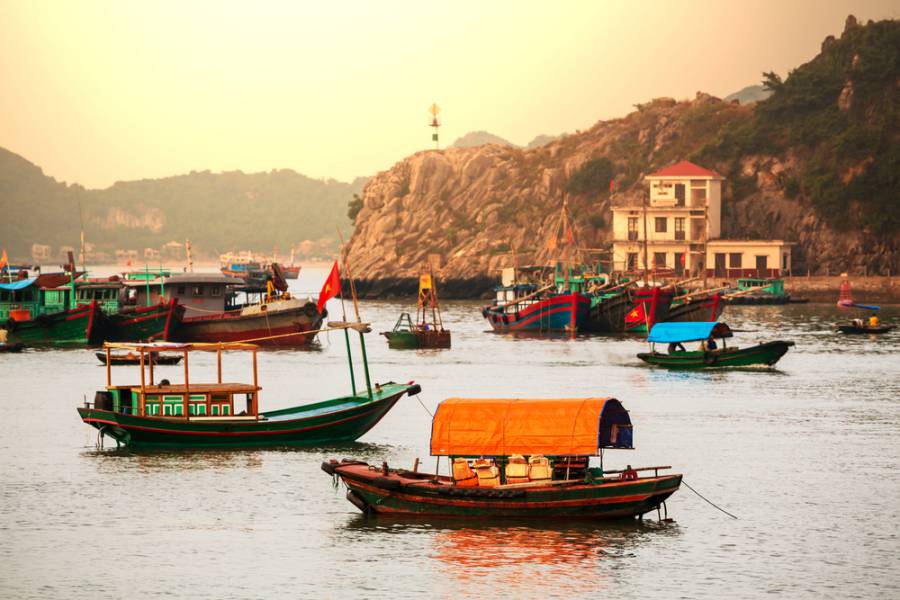The co-founders of Marou Faiseurs de Chocolat recount how they set up a business making and marketing fine chocolate in Vietnam, a country not known for its production or consumption of the product.
Dmitry Minkov, his wife Nina and their 5-year-old daughter, Varvara, are on their way to a chocolate factory on the outskirts of Ho Chi Minh City. The Minkovs are Ukrainians residing in Singapore, where they run a chocolate store. On holiday in Vietnam, they decide to check out how one of their best-selling chocolates is made and listen again to the improbable story of how it came about.
Their taxi pulls up outside a blue iron gate on a dusty street in Thu Duc district, having traveled 15 kilometers from their city hotel. A couple from Dublin joins them. Inside the gate is a factory complex housing three small-to- medium-sized businesses. Sam, a bearded and bespectacled Japanese-Frenchman who has lived in Vietnam for eight years, is their guide. He leads them past a small cacao plant at the entrance of the factory, stopping in front of a wall of hessian bags filled with cacao beans. To his left, where the tour begins, are several roasting machines blowing cacao aroma and husks in the air; through a double-glass door into a sealed room where the cacao is conched into a liquid mass by 12 machines imported from India. Another door takes them into a controlled compartment where the liquid is tempered and poured into plastic molds, refrigerated for 30 minutes, then hand-wrapped by the Vietnamese staff; and finally into the storeroom where the bars are stacked, boxed and labeled: ready for delivery.
At the end of their bean-to-bar journey, the visitors taste the finished product and marvel at how such fine chocolates came to be made in Vietnam—a country not known for its production or consumption of chocolate—by two chocolatiers who, until recently, as one of them admits: “Didn’t know how to make chocolate.”
The Marou Tale
Four years ago, 41-year-old Sam Maruta and 43-year-old Vincent Mourou—dropouts from the banking and advertising industry, respectively—founded Marou Faiseurs de Chocolat, a company specializing in single-origin chocolate and based in Ho Chi Minh City. Single-origin refers to an estate or plantation, or more often a country, where the beans used to create the chocolate come from. Their ambition was to create Vietnam’s first bean-to-bar chocolate. Four years later, Maruta and Mourou have surprised the world with a recognized brand of quality chocolate bars, built a profitable business and by their success have put their adopted country on the chocolate map.
“The idea of making chocolate was interesting,” Maruta says. “Making chocolate but, importantly, making it into bars, and making it in the country where the cacao comes from.”
This was back in February 2011, when the former banker from Société Générale and his soon-to-be business partner experimented with beans bought from a farm found by the side of the road.
“We bought a couple of kilos of beans and on the way back decided to try to make chocolate from those beans. At the time, we didn’t know how to make chocolate and didn’t know the difference between what was good and bad cacao,” Maruta tells the story from an air-conditioned office crowded with staff bent over laptops and clamped to cellphones, a long way from the kitchen where he and Mourou grounded and molded their first chocolate bars from cake tins. “I had a house with a grinder and an oven; rare things [in Ho Chi Minh City] then,” he recounts.
Jonathon Waugh, a friend-cum-investor, picks up the story. “I remember going to Sam’s kitchen and tasting his chocolate. It wasn’t half bad, I thought at the time.
“Some months earlier, Sam came to me and said, ‘There’s a market for high-end artisanal chocolate and I’m going to do it—would you be interested in putting some money into it?” Waugh continues. “‘Let me come and taste your chocolate first,’ I said.”
By the end of that evening, Waugh, a former fund manager with more than 20 years of experience under his belt, found himself saying, “All right, done; I’m in!”
“I invested [in Marou] without any feasibility study, any business plan,” Waugh, 45, reflects on the decision four years later. “It was really trust in Sam. There are many reasons for their success, but he’s the key. He doesn’t realize he’s actually a great marketer; one of the most captivating things is listening to him talking about his passion.”
Before backing the bean-to-bar business, Waugh, a Brit who moved to Vietnam in 1996 and later co-founded the fund management firm PXP Asset Management, had invested in a garment factory, a tourist company and a microfinance start-up.
“Of all my investments, Marou is by far the most surprising and satisfying,” Waugh says. “Surprising in that it has gone way beyond the parameters of where we initially thought it would operate. Satisfying because it is the first company in Vietnam, or at the very least within the [food and beverage] sector, that was conceived, created and branded in the country to produce something that is exported and recognized globally as a luxury edible product.”
For expat entrepreneurs like Maruta and Mourou, Vietnam offered something else not mentioned in the business guidebook: the freedom to do what you like.
In its first full year of operation in 2012, Marou’s revenue was $120,000. It is expected to be $1 million this year. Today, with a staff of 20, the factory in Thu Duc churns out 100 kilograms of chocolate a day. In 2014, it produced 3 tons of chocolate, 70% of which was exported to more than 20 markets overseas, mainly to Europe. Their largest market, unsurprisingly, given the founders’ French heritage, is France. Later this year, Marou will open its first chocolate patisserie near Ben Thanh market, a shopping and tourist magnet in Ho Chi Minh City.
Starting Up in Vietnam
The Vietnam War ended 40 years ago. When the guns fell silent, the clamor for a better life began, and though the apparatchiks of the ruling Communist Party have never relinquished control, those calling for Western-style market reforms tended to get the upper hand each time the economy came unstuck, as it did in the decade after the war, during the Asian financial crisis of 1997-1998, the global financial slump of 2008 and more recently the local downturn in 2012. Beginning in 1986, when the country made the shift from a centrally planned economy to a “socialist-oriented market economy” under the policy slogan Doi Moi (renovation), Vietnam has chalked up three decades of high growth. In the last decade, it has recorded an average gross domestic product (GDP) growth rate of 6.4% per year, according to the World Bank. Vietnam’s Ministry of Planning forecasts a growth rate of 6.4% for this year.
“Over the past 30 years, policy has swung back and forth, sometimes favoring growth, sometimes stability,” author and journalist Bill Hayton writes in Vietnam: Rising Dragon. “Vietnam’s achievements in reducing poverty are impressive. In 1993, according to government figures, almost 60% of the population lived below the poverty line. By 2004, that figure was down to 20%.” The country has met most of the Millennium Goals, the development targets set by the United Nations. It thus has escaped the ranks of the poorest countries to join the group of “middle-income states.” “People’s living standards are soaring, their horizons are widening and their ambitions are growing,” Hayton added.
In April, Swiss bank UBS released a report with the eye-catching headline “Vietnam: Potentially One of the Most Exciting Markets in Asia.” The country, the report said, has many of “the building blocks for rapid growth,” such as a large, young population—almost 50% of Vietnamese are under 30—an emerging consumer class and a pool of cheap labor—wages are half of those in China and Thailand.
“It is very easy to get excited when looking at Vietnam from the outside,” Waugh, a long-time observer of the economy with experience at Baring Asset Management, Jardine Fleming and JP Morgan Chase, says. “It is a place of great opportunity due to its stage of development, attractive demographics, decent educational standards, geographic position and motivated, sizeable population. However, once you step in and try to execute a business plan [it] is often fraught with ongoing hurdles such as excessive red tape, a poor legal system, weak banks and currency issues, to name but a few.
“All start-ups face an enormous number of risks, but start-ups in ‘frontier’ markets face additional layers of risk. It’s a tough business environment, and not for the faint-hearted,” he adds. “[But] for those entrepreneurs armed with patience and funding … the rewards can be extraordinary in the long-term.”
For expat entrepreneurs like Maruta and Mourou, Vietnam offered something else not mentioned in the business guidebook: the freedom to do what you like.
“If you want to start a business like making chocolate in France,” Maruta says, “the most difficult hurdle is going to be in people’s eyes: Who are you to make chocolate? What’s your legitimacy for making chocolate? Have you studied chocolate-making? Have you come from a chocolate-making family? Here in Vietnam, it’s a case of do what you want. There is a sense of freedom [here].”
And where others might see opportunities in low-skilled labor and low-cost environment, the founders of Marou saw opportunities in skilled workers producing quality goods.
“It’s counterintuitive,” Maruta says. “People see Vietnam as a place for making cheap stuff; we decided to go niche and upmarket. We invested heavily in design, in doing things in a way that is not cheap, and going for a premium product. It’s going against the grain, against the flow that … makes us stand out.”
A good example of this can be seen in the design of their chocolate wrapper. Nearly a year in the making, the design team at Rice Creative, also based in the southern capital, went through many templates before they struck gold—literally. In 2003, one of their designs picked up the top prize at an international award for chocolate wrappers; the judges described the winning wrapper as “beautiful enough to frame.”
Designers Joshua Breidenbach, 33, and Chi-An De Leo, 31, tell of their commission: “Our brief was single-origin chocolate, and at the time no-one had heard of handmade chocolate. [Maruta and Mourou] knew it would be difficult to introduce the chocolate to the gourmet market, so we had to come up with a design that would work.
“It took us nine months to get it right; there were many iterations. We looked for patterns found in Vietnamese textiles. The colors come from the natural colors of the cacao pods … We used traditional silk-screen printing techniques to hand print each wrapper.”
The final look is a golden monotone of traditional lattice patterns decorated with hand-drawn flora, fauna, and clouds and set in modernist typography on a thematic color. Five colors—green, yellow, sky-blue, red and purple-blue—were chosen to match the colors of the cacao pods and reflect the regional flavors of the bars. The design caught the eye of editors of design magazines like Wallpaper and foodies across Europe.
“Our first order was from La Grande Epicerie de Paris, one of the most prestigious food outlets in France,” Maruta says. “What really helped there was the design. They asked us [after] seeing the design.”
“Marou packaging is a piece of art,” says Minkov, part of that recent tour group and owner of Hello Chocolate!, a supplier of quality chocolate in Singapore. “Traditionally, people buy chocolate as gifts; that is why people pay attention to the packaging. The quality of the product is important, but customers pay a lot attention to the packaging because it looks expensive but is affordable. And Marou is famous for their packaging.”
 Hello Chocolate!, part of the Vara Group which represents tennis star Maria Sharapova’s candy brand, Sugarpova, sells a selection of gourmet chocolates in Robinsons on Orchard Road, a high-end retail destination in Singapore. Minkov discussed the merits of the Marou brand while standing among the white shelves on the lower floor of Robinsons stacked with brands such as Akesson’s, Beschle, Omno, Pacari and Marou.
Hello Chocolate!, part of the Vara Group which represents tennis star Maria Sharapova’s candy brand, Sugarpova, sells a selection of gourmet chocolates in Robinsons on Orchard Road, a high-end retail destination in Singapore. Minkov discussed the merits of the Marou brand while standing among the white shelves on the lower floor of Robinsons stacked with brands such as Akesson’s, Beschle, Omno, Pacari and Marou.
“Marou is one of our bestsellers,” he says. “They have a loyal customer base of dark chocolate lovers, who come specifically to this place to find Marou.”
Back on the Farm
Ho Van Lau, 62, a farmer from Ap Bac, a village in Tien Giang province, is ducking and weaving between the branches of the cacao trees on his one-hectare plantation. Introduced by the French in the late 19th century, the cacao tree can still be found in the southern highlands and the Mekong Delta, a network of rivers and floodplains that contributes more than 50% of Vietnam’s staple food crops and 27% of the country’s GDP.
Lau has been a farmer for as long as he can remember. His parents tilled the fields he and his wife now call their own. Like most farmers in his village, he and his family survived the war—“I could hear gunfire all day long”—and the postwar privations on the rice and vegetables that are grown on their family farm. That was until a decade ago when Lau switched to cacao. His timing was fortuitous, coming at a time when the government was plowing resources into the crop as part of a plan to diversify its agriculture base and to take advantage of the high cacao price on the international market. With the help of foreign aid, local farmers like Lau were given incentives to grow and expand their plantations. Ten years ago, cacao covered less than 2,000 hectares in Vietnam; now there are more than 54,000 hectares.
“The cacao tree takes five years to fruit and can fruit for 40 years,” Lau, who sells his cacao to Marou, explains. “They like to grow in the shade, but they don’t like it when there’s too much water; their roots go rotten, so we have to drain the water,” he adds, standing amid a network of small canals that flow alongside rows of cacao plants.
Thriving in the shade of the tropical forest, the cacao tree produces large fruit-pods in ripening stages of green, yellow, blue, red and purple-blue—the colors of the Marou wrappers—which hang directly off its trunk and branches on inch-long stems.
Lau picks up a pod and splits it in half with a metal bar. Inside are dozens of seeds—cacao beans—buried in a white sticky pulp.
“Once the beans are picked they are fermented for six days, then dried for another seven days before we put them in these bags,” Lau says as he walks from the sweatboxes—square wooden boxes—where the beans are fermented under layers of banana leaves and hessian cloths, to a raised bamboo rack, six meters long and one-and-a-half meters wide, where they are dried, and to a corner of his living room where half a dozen large bags stuffed with beans lean against the wall.
“Marou wants clean cacao,” Lau says. “The fermentation process is important, so we scrub the [sweatboxes] clean and we turn the beans [during fermentation] once a day. They also insist on no pesticides, no chemicals.”
Marou names its five signature chocolate bars from the five provinces—Tien Giang, Dong Nai, Lam Dong, Ba Ria and Ben Tre—where the cacao is sourced. In 2013, Marou’s Tien Giang 70% bar picked up Silver in the “best dark chocolate bean-to-bar” category at the Academy of Chocolate Awards in London. One critic praised its “mocha aroma” and “velvety finish” qualities that in the world of single-origin chocolate can be traced back to the area where it’s grown—that is, on Lau’s farm.
Wistfully, the farmer says he wished he could try his hand at turning his cacao into chocolate, “but with my five children gone [to the city], and with just me and my wife, we can just do the beans.
“It’s easy work,” he adds. “There are only two harvests a year; one in May and one in October. We hire a couple of helpers to pick the cacao pods.”
Already this year, Lau has sold 840 kilograms of cacao—worth $3200 — to Marou. In a country where the average salary is $500 a month, that is a good yield. “Business is doing well,” the farmer says.
*[This article was originally published by Fair Observer’s partner, Knowledge@Wharton.]
The views expressed in this article are the author’s own and do not necessarily reflect Fair Observer’s editorial policy.
Photo Credit: Billion Photos / Vitaly Korovin / Galyna Andrushko / Shutterstock.com
 We bring you perspectives from around the world. Help us to inform and educate. Your donation is tax-deductible. Join over 400 people to become a donor or you could choose to be a sponsor.
We bring you perspectives from around the world. Help us to inform and educate. Your donation is tax-deductible. Join over 400 people to become a donor or you could choose to be a sponsor.
Support Fair Observer
We rely on your support for our independence, diversity and quality.
For more than 10 years, Fair Observer has been free, fair and independent. No billionaire owns us, no advertisers control us. We are a reader-supported nonprofit. Unlike many other publications, we keep our content free for readers regardless of where they live or whether they can afford to pay. We have no paywalls and no ads.
In the post-truth era of fake news, echo chambers and filter bubbles, we publish a plurality of perspectives from around the world. Anyone can publish with us, but everyone goes through a rigorous editorial process. So, you get fact-checked, well-reasoned content instead of noise.
We publish 2,500+ voices from 90+ countries. We also conduct education and training programs
on subjects ranging from digital media and journalism to writing and critical thinking. This
doesn’t come cheap. Servers, editors, trainers and web developers cost
money.
Please consider supporting us on a regular basis as a recurring donor or a
sustaining member.
Will you support FO’s journalism?
We rely on your support for our independence, diversity and quality.








